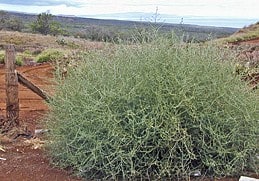Beneficial fungi could become microbial marshals tasked with wrangling a weedy icon of the American West, Salsola tragus—also known as tumbleweed or Russian thistle.
Popularly depicted in movies and television tumbling through dusty towns of the Old West, tumbleweed is in fact one nasty hombre of the western American landscape, elbowing aside crops, clogging irrigation ditches, spreading insect pests, and even posing a driving hazard.
Large-scale infestations, especially on low-value agricultural lands, can make chemical or cultural control too costly or impractical, according to U.S. Department of Agriculture (USDA) plant pathologist Dana Berner. He works at the Agricultural Research Service (ARS) Foreign Disease-Weed Science Research Unit in Frederick, Maryland. ARS is USDA’s chief intramural scientific research agency.
In studies at Frederick, Berner and his colleagues are evaluating certain fungi with potential to biologically control tumbleweed, an invasive species that entered the United States in the 1870s as a flax seed contaminant.
Their most promising fungal candidates, Uromyces salsolae andColletotrichum salsolae, were originally isolated from infected thistle plants in Russia and Hungary and exported to the ARS Frederick lab under permit for quarantine study. In Biosafety Level-3 greenhouse containment, the researchers exposed plant specimens from 64 different species to U. salsolaeand 89 species to C. salsolae and gauged the plants’ reactions and disease symptoms, if any.
To broaden the scope of their host-range tests—critical to ensuring the fungi won’t harm non-target plants or crops once released—the team used an approach called BLUPs, short for “mixed model equations that produce Best Linear Unbiased Predictors.” Using a disease ranking system and matrix information, BLUPs predict a plant species’ susceptibility based on how genetically similar it is to the targeted weed—Russian thistle, for example.
Based on the information, the researchers have submitted petitions seeking recommendation for release of the two fungi from theTechnical Advisory Group for Biological Control Agents of Weeds, which comprises members from federal and state regulatory agencies, as well as from Canada and Mexico.
Read more about this research in the September 2014 issue of Agricultural Research magazine.
If our reporting has informed or inspired you, please consider making a donation. Every contribution, no matter the size, empowers us to continue delivering accurate, engaging, and trustworthy science and medical news. Independent journalism requires time, effort, and resources—your support ensures we can keep uncovering the stories that matter most to you.
Join us in making knowledge accessible and impactful. Thank you for standing with us!

